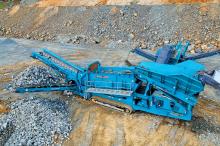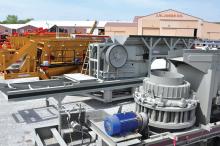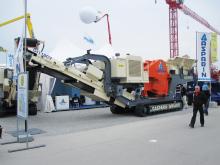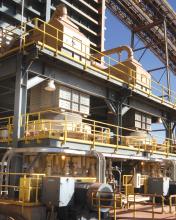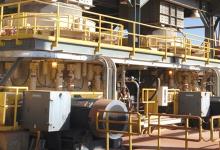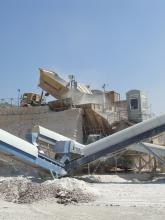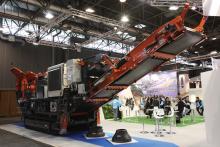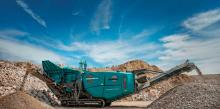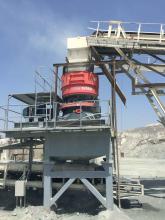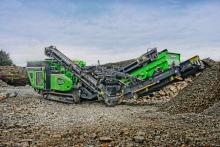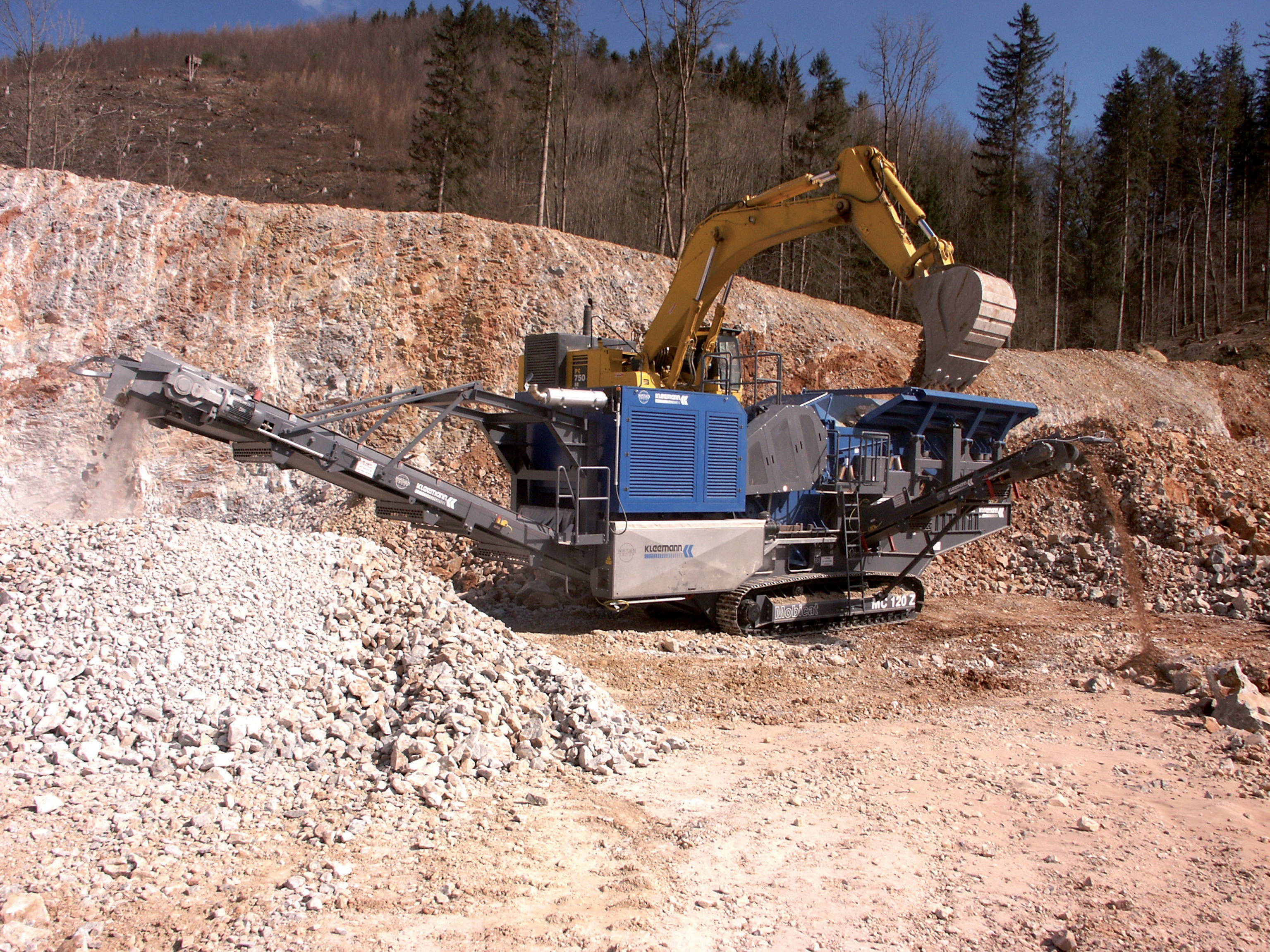
The recycling and minerals extraction markets now share technologies, Mike Woof reports
Not surprisingly, the Steinexpo quarrying event in Germany was a key launch venue for new crushing and screening technologies, as well as associated quarrying technology. Crushing and screening equipment firms from a wide range of European countries including Austria, the Czech Republic, Germany, Ireland, Italy, Sweden, Switzerland and the UK were present at the exhibition.However it was noticeable how closely the minerals extraction and materials recycling markets are now becoming, particularly in the crushing and screening equipment sector. Recycling of old asphalt and concrete from the construction sector is growing apace, boosted on two sides. As the costs involved in extracting fresh aggregates and sourcing oil products increases and the cost and legislation required in dumping old materials grows, recycling becomes more and more attractive commercially.
With tough legislation across the European Community on the opening of new quarries, the minerals extraction and construction industry are coming together to develop the commercial aspects of recycling. Crushing equipment manufacturers have taken note, offering a spectrum of technologies that can be used in both applications and an innovative array of technologies is coming to market at present.
German crushing equipment firm
In the meantime, Kleemann says it is enjoying strong sales for its cone, jaw and impact crushers. The high performance of the impact crusher is said to attract customers wanting a quality machine, according to the firm. In addition Kleemann says it is also seeing strong sales for its novel electrically-powered mobile jaw crushers. The MC120Z suits both quarrying and concrete recycling duties, with its 1200mm wide by 800mm deep inlet. The machine is designed for a feed capacity of up to 400tonnes/hour. Key features include pre-screening by a double-deck heavy-duty screen, as well as a vibrating discharge chute fitted as standard below the crusher. Conventional diesel power is used to track the machine into position with the electric motor then being used for crushing, making a huge reduction in running costs. At the moment this diesel electric option is only available on the mobile jaw crushing machines although it may be extended to the impact crushers and cone crushers later. The firm also showed its latest mobile MOBISCREEN MS 16 D screening plant, which features an 8m³ slotted screen that can be folded remotely, while the machine offers a feed capacity of up to 350tonnes/hour. The triple-deck screen allows four different grain sizes to be produced in a single working pass.
A similar strong demand for machines is being seen by Italian crushing equipment specialist OM, boosted by a growing market into recycling. According to the firm's Gerardo Piccolo, "For us this year is fantastic. For the first time the German market has been bigger for us than the Italian market." The firm's 30tonne Argo model is a particularly strong seller in Germany although Piccolo has high hopes for the 35tonne Ulysses model launched recently.
OM's growing presence in the crushing equipment sector is significant given that only a few years ago it sold machines predominantly to its home market. Piccolo said that OM has seen a 15-20% growth/year in exports since 2000 when the company first made serious moves to develop sales out of Italy, where it had become a market leader. At present some 85% of the firm's production is now being exported outside of Italy.
Piccolo explained that the growing trend towards recycling of materials has boosted sales in Germany. "Today the German market is interesting for us and is the most important market," he said, adding that while the aggregate production is still an important sector for OM's German sales, recycling of asphalt and concrete (and the latter in particular) has helped drive the firm's market growth in the country.
Piccolo is confident too that the recently introduced Ulysses crusher will attract sales. This machine features a self-sensing system that continuously monitors load in the jaws of the crusher and enables the machine to optimise performance. Because this OM machine has hydraulics operating directly onto the jaw, the new electronic system is able to monitor pressures continuously and accurately than previous mechanical monitoring methods. Piccolo said, "We adjust the feed to ensure the crushing chamber is at the optimum level. We slow down and speed up the feeder but we never stop it. The machine adjusts the pressure for optimum crushing and it is a self-learning system." This method of optimising material levels in the crusher allows for greater performance consistency and Piccolo said, "When you are able to keep the level within 10%, you have 10-15% higher output efficiency." He added that this system can also quickly determine whether any tramp metal has entered the machine that needs to be removed, preventing damage to the wear plates. Other benefits for the latest OM machines include the use of Rosta-type elastomers instead of springs in the feed system and Piccolo said that this allows for a finer control of speed. The firm has also recently introduced a powerful 19tonne jaw crusher unit that can be used in tough quartz and basalt applications.
In the Czech Republic, PSP is a leading supplier of both mobile and static crushing equipment and intends to extend its range with the launch of a new cone crusher. This will start its testing phase in around six month's time at a quarry close to the PSP factory and a spokesperson for the firm said, "We can test and control it straight from the factory. It is a high throughput crusher" Output is expected to be in the 180-200tonnes/hour range with output sizes variable from 0-20mm and including its drive unit, it weighs 12.5tonnes (and 15tonnes including all the hydraulics). The castings for the new KDN24P are also being made at PSP's own facility and the firm hopes to build on its sales in the Czech home market as well as for its exports, which are particularly strong to Ireland and Italy at present.
Rockster says that its new screening box represents a new diversion for the Austrian firm. Previously the company had solely targeted the mobile crushing equipment sector but is now broadening its horizons into screening as well. The screening box comes as an additional unit to the firm's now proven mobile crusher, itself a fairly recent introduction. Using the return belt on the 10tonne screenbox allows the customer to achieve a 100% final product size, without need for further screening using a separate plant.
Highly versatile, this relatively compact 27.5tonne mobile machine is available in what the firm describes as a duplex system, allowing the user to switch from jaw crushing to impact crushing layout. The jaw unit can be removed comparatively quickly using lifting equipment and replaced by the impactor, or vice versa, to suit different applications. This layout is also said to reduce purchase costs for the customer, who is able to buy a single base unit comprising chassis, engine and drive along with the separate impactor and jaw crushing modules.
A number of features of the Rockster mobile crushing system are protected by patents and the firm hopes to develop a strong position in the recycling and aggregate sectors with this technology. Wolfgang Kormann, managing director of Rockster said, "Demand for recycling equipment is growing because it is difficult to get permission now for quarrying. With this you can switch from a jaw to an impact crusher and do different applications with one machine." Kormann added that the machine can be used for recycling both aggregate and concrete, while a magnet is available to separate rebar and other tramp metals from the crushing stream. The two machines allow the customer to produce three product sizes, 0-8mm, 8-16mm and 16-32mm, using different discharge points. Productivity varies depending on the application and material, with a maximum input of up to 200tonnes/hour when producing a 32mm sized material although Kormann added that the inherent stickiness of asphalt tends to result in a lower throughput in a recycling operation than for concrete.
Improved performance and reliability are claimed for the latest
Another new development from the firm include its innovative HX410 dust suppression package which uses charged particles to reduce airborne dust and is suitable for use at transfer stations.
Aftermarket sales business is a key focus for Sandvik in the quarrying sector and the firm achieves some 40% of its turnover from this market at present. However the company wants to boost its aftermarket business further and its target is to achieve 50% of revenue from the sector in the near future.
Aimed at use in large static crushing plants from Shulte Strathaus is a highly productive new conveyor system that is able to handle an impressive 450m³/hour of material. This can be offered with belt widths from 800mm-1.4m and uses Fenner
Also from Austria, Western Retek is offering a new mobile impact crushing plant to the European, North American and Russian markets. The machine is now available following two years of testing and is the first unit from this firm, with more models due. One of the firm's representatives said, "A jaw crusher is in development at the moment." Interestingly, the firm intends to offer these 36tonne mobile crushers with a modular design. The representative said, "We are working on a flexible system that means customers will be able to switch the machine from an impact to a jaw crusher." A cone crusher is also in development although it is not likely to be ready for the market for another 12 months, while the jaw crusher should be finished its testing phase and on the market in six months time. A more powerful and more productive 50tonne machine is also in development. The design of the firm's basic 36tonne mobile machine will allow the user to remove the impact crushing module and replace it with the firm's jaw or cone crushers but using the same drive unit and chassis. This allows the customer to change the machine from one type of crushing operation to another, increasing its versatility. This also offers a cost-effective solution in comparison with conventional equipment as buying the single chassis with two or three crushing modules will be considerably cheaper than buying two or three separate machines. The modular design also helps reduce shipping costs considerably as this mobile crusher can be taken apart completely and transported in a standard container, rather than having to be shipped as a complete unit.
Hardox steel up to 30mm thick is used in the impact crushing chamber, which is said to improve its wear life, while the machine is also said to have a highly efficient pre-screening system as well as a two-stage grizzly. Other features include the use of reliable and proven components such as a Caterpillar diesel and
Quarry output
An Irish quarry operator is maximising production of Donegal Quartz with a combination of crushing and screening equipment from Sandvik and Sandvik group company Fintec. County Donegal-based Muckish Sand & Gravel has an equipment fleet that comprises some six Fintec machines and a Sandvik crusher. The family firm is using this equipment combination to produce a broad range of products won from its quarry at Fallay, County Donegal.
Each blast at the quarry generates around 25,000tonnes. Depending on the specific material requirement at any given time, the blasted rock is processed by a combination of the six Fintec machines and by a Sandvik C3 crusher. Along with the Sandvik C3, the firm runs a Fintec 1107 that acts as a primary crusher and a Fintec 1080 that helps produce the right product shape. In addition, the company has a Fintec 640 scalping screen, a Fintec 540 three-way screen and a Fintec 570 unit.
Meanwhile, Irish crushing and screening contractor Kyrush is now using an Extec C12 track-mounted mobile crusher, an Extec E7 screen and a Fintec 542 screen in both quarrying and recycling applications. The firm is usually called into a quarry after blasting to produce materials for stockpiling or onward sale and has tapped a trend for outsourcing crushing and screening duties to contractors.
The Extec and Fintec machines generally work in train together, with the Extec C12 acting as a primary crusher and feeding the Extec E7, which carries out initial screening duties. The Fintec 542 is then used for separating customer-specified grades. Because the machines are track-mounted they can be deployed quickly once on-site but have also demonstrated high productivity, versatility and reliability.

